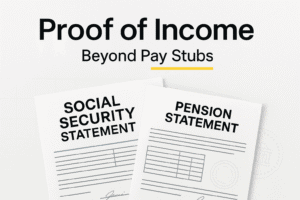How Landlords and Loan Officers Detect Fake Pay Stubs

Whether you’re screening a tenant, underwriting an auto loan, or checking income for a small-business line of credit, you will encounter pay stubs (US), payslips (UK), and employer payroll summaries (UK/CA). Unfortunately, fake pay stubs and manipulated income documents are common—some are obvious, others pass a casual glance. This guide shows how professionals detect falsification without violating privacy rules, and where formatting/legibility edits are acceptable. It’s written for landlords, property managers, loan officers, brokers, and compliance teams across the US, UK, and Canada.
Our role at FinancialDocsProvider.com: we help applicants and reviewers by organizing, reconciling, and proof of income editing for clarity—redaction, readability, and export fixes. We do not fabricate numbers, shift dates, or impersonate employers. If income data is wrong or missing, we’ll flag it, not “massage” it.
By the end, you’ll know which tools and databases to rely on, what edits are allowed, how to package a clean income file, and which red flags instantly send a file to secondary review.
Legality Basics: Formatting vs. Falsification (US, UK, Canada)
Across jurisdictions, the dividing line is simple: formatting and redaction that do not change the facts are generally fine; altering amounts, dates, employers, or identity details is not. Fraud statutes, identity theft laws, and unfair/deceptive practices rules can apply to both the applicant and anyone who knowingly assists.
United States
In the US, deceptive income documents can implicate state fraud laws and federal prohibitions on unfair or deceptive acts. Reviewers should also understand applicant rights and adverse action duties. See the CFPB regulations resource for consumer compliance frameworks, and the FTC’s business guidance for deceptive practices. Tax misstatements intersect with IRS rules—see IRS.gov for official guidance.
United Kingdom
In the UK, presenting falsified payslips or employer letters can violate fraud laws and lead to tenancy or lending refusal. Landlords and agents must handle personal data under UK GDPR; lenders and brokers observe FCA conduct standards. See the FCA’s handbook and GOV.UK’s guidance on identity and right-to-rent/right-to-work checks on GOV.UK.
Canada
In Canada, deceptive submissions can violate provincial and federal laws, and reviewers should observe privacy obligations. For consumer education and rights, see the Financial Consumer Agency of Canada (FCAC) and tax references via the Canada Revenue Agency (CRA).
What Edits Are Allowed (Without Changing Facts)
Legibility and privacy are crucial. A reviewer must be able to read amounts and dates, and applicants have a right to protect sensitive identifiers. These edits are typically acceptable when they do not alter factual content and when you maintain an audit trail:
Redaction
- Mask the middle digits of SSN/NINO/SIN (e.g., XXX-XX-1234) and account numbers.
- Redact personal addresses on pay stubs/payslips if the lease/mortgage file already contains verified address docs.
- Remove QR codes or barcodes that expose internal IDs, as long as they’re not needed for verification.
Legibility & OCR
- Straighten, de-skew, and increase contrast so text is readable.
- Run OCR and embed a text layer so underwriters can search figures.
- Flatten transparencies to prevent “missing text” when viewed in certain PDF readers.
Export & Packaging Fixes
- Convert images (JPG/HEIC) to PDF, combine pages, and remove duplicate headers/footers caused by mobile scanners.
- Insert divider pages or bookmarks for multi-month packets.
- Normalize date formats (e.g., DD/MM/YYYY vs. MM/DD/YYYY) with a cover sheet that clarifies the convention.
Need help with tidy, readable files? Explore our bank statement formatting and other organization services.
What’s Illegal (and Why It Matters)
Any edit that changes the substance—who paid whom, when, or how much—is risky and may be outright fraud. That includes inventing employers, backdating stubs, or “rounding up” hours to qualify. The same applies to bank statements and tax forms. Even if you see “template” language online, changing facts on a financial record can expose applicants to denial, collections, or prosecution—and expose reviewers to compliance findings if they ignore obvious red flags.
Potential Consequences
- File denial and adverse action with documentation retained by the lender/landlord.
- Legal exposure under fraud and deceptive practices statutes; possible fines or criminal charges in severe cases.
- Reputational harm and internal escalation for reviewers who accept questionable documents without proper diligence.
Use Cases & Practical Verification Paths
Below are common scenarios for US, UK, and Canada. The goal is simple: triangulate income by comparing pay documentation to third-party records or independent calculations.
Residential Rentals
Scenario: A tenant supplies two recent pay stubs showing $2,000 net per period and a bank statement with matching deposits.
- Confirm pay frequency (weekly, biweekly, semi-monthly) and total gross-to-net math.
- Cross-check bank deposits by date and amount. Expect timing lags (ACH vs. paper check).
- Verify employer existence and contact information via official website or trusted directories (not just social profiles).
- If available, use employment verification services (where authorized by the applicant) to confirm hire date and status.
- Apply your rent-to-income policy consistently. Document the basis for approval/denial.
Auto & Specialty Finance
Scenario: A buyer claims overtime income and shift differentials.
- Compare year-to-date (YTD) totals to the pattern of base hours plus overtime indicated on stubs/payslips.
- Recalculate effective monthly gross income based on verified frequency and YTD progression.
- Validate employer identity and address; check for cloned logos or mismatched fonts.
- For gig income, request platform 1099s or statements plus bank deposits that match ride/delivery payouts.
Small Business & SBA-Type Reviews
Scenario: A sole proprietor lists variable monthly income.
- Collect two years of tax returns (US: Schedule C; UK: SA302; CA: T1 with Statement of Business Activities), plus current-year YTD P&L.
- Reconcile deposits to invoices/contracts where feasible.
- Check business registration and active status. Avoid relying on unverified screenshots.
W-2/UK Payslip vs. Self-Employed Packets
- Employees (US W-2 / UK payslip / CA T4): Use recent stubs plus YTD math; cross-check against consistent deposits. End-of-year W-2/T4 corroborates annual totals.
- Self-employed (US 1099 / UK SA302 / CA NOA): Use tax returns, notices of assessment, and bank statements showing business activity. Expect variability—focus on documented averages.
How We Work: Intake → Reconciliation → Formatting → Delivery
Our service is built for clarity and compliance. We organize what you already have, make it readable, and package it so reviewers can quickly verify facts.
1) Intake
- We receive your docs (pay stubs/payslips, bank statements, tax forms) and confirm scope: redaction, legibility, and export fixes only.
- We request written applicant consent if verification calls or system checks are needed by your team.
2) Reconciliation
- We align reported pay frequency, YTD math, and deposit timing to identify gaps.
- We flag anomalies so you can request originals or additional proof—no “massaging” of numbers.
3) Formatting
- OCR, contrast, page order, bookmarks, and privacy redactions.
- Normalize date formats, annotate pay frequency on a cover sheet, and bundle supporting docs logically.
4) Delivery
- We deliver a clean PDF packet with a change log for any purely formatting edits.
- Turnaround is typically same-day to 48 hours, depending on volume.
Curious about scope and about our process? Review our service overview or check pricing. For custom timelines, contact our team.
Compliance Checklist & Packaging Tips
Use this quick checklist to keep your file clean and defensible.
Document List (choose what applies)
- Last two to four pay stubs/payslips with YTD totals
- Two to three months of bank statements showing payroll deposits
- End-of-year tax forms (US: W-2/1099; UK: P60/SA302; CA: T4/NOA)
- Employment letter (if policy allows) confirming role, status, and base pay
Packaging & Naming
- Bundle in this order: cover sheet → stubs/payslips → bank statements → tax forms → optional employer letter.
- Use consistent file names:
LASTNAME_FIRSTNAME_Income_2025Q2.pdf. - Include a one-page summary: pay frequency, average monthly gross, and verification method used.
Consent & Privacy
- Get written applicant consent for employer verifications and any third-party database checks.
- Redact sensitive identifiers (SSN/NINO/SIN) except what your policy requires.
Math Cross-Checks
- Confirm gross-to-net math against stated deductions and YTD.
- Check that bank deposits align with pay dates and net amounts (allow for weekends/holidays).
- Spot test overtime or variable pay by comparing hours to YTD progression.
Common Red Flags That Trigger Rejections
These indicators don’t prove fraud by themselves, but they warrant secondary review or requests for originals.
Visual/Layout Flags
- Fonts that shift mid-line or kerning that looks “wobbly.”
- Logo or EIN/CRN that appears as a blurry image while surrounding text is crisp.
- Inconsistent date formats (e.g., “03/02/25” and “2 March 2025” on the same stub).
- Exact round numbers for hours or overtime every period without variation.
Arithmetic & YTD Flags
- YTD totals that don’t equal the sum of prior periods plus current period.
- Tax withholdings that don’t scale with gross pay (e.g., identical withholding on different grosses).
- Net pay that never changes despite varying pre-tax deductions.
Metadata & File Integrity Flags
- “Creator” field shows consumer editing tools or web generators known for fake stubs.
- Multiple overlays or objects where a genuine payroll export should be flattened.
- Mismatch between stated pay frequency and deposit cadence in the bank account.
Employer/Database Flags
- Employer not found in corporate registries or payroll contact numbers route to mobile/VoIP lines with generic voicemail.
- Employment verification services, where used with consent, cannot confirm status, start date, or pay frequency.
Mini-Scenarios
Scenario A: Applicant shows three biweekly stubs but bank shows monthly deposits. → Ask for originals and a payroll letter; confirm whether applicant is paid via paper check that’s deposited monthly.
Scenario B: YTD increases smoothly, but hours fluctuate widely with no change in gross. → Recalculate based on contract base pay; request detailed earning statements.
Helpful Resources (Official & Internal)
Official Guidance
- United States: CFPB Regulations • FTC Business Guidance • IRS
- United Kingdom: GOV.UK central portal (right-to-rent/work guidance; general compliance)
- Canada: FCAC • CRA
Internal Links (How We Help)
- Need tidy, readable income packets? See our proof of income editing.
- Bank statements messy or mis-ordered? We handle bank statement formatting.
- Budgeting your review? Check our pricing.
- Questions on scope or SLAs? Contact our team or learn about our process.
Frequently Asked Questions
Is editing a pay stub ever legal?
Yes—formatting and privacy edits (redaction, legibility, file conversion) are acceptable when they do not change facts. Altering amounts, dates, or employer information is not legal and may be fraud.
How do lenders or landlords verify income without violating privacy?
Collect consent, then triangulate: compare pay stubs/payslips to bank deposits, confirm employer details through official channels, and—where policies allow—use third-party employment verification services. Keep an audit trail and apply your criteria consistently.
Are online “pay stub generators” acceptable?
Templates are not evidence. If a generator output reflects true payroll, the employer’s official payroll records should match it. If it conflicts with bank deposits, YTD math, or employer confirmations, expect rejection.
What should self-employed applicants provide instead of pay stubs?
Tax returns (US: 1040 with Schedule C; UK: SA302; CA: T1/NOA), bank statements showing business deposits, invoices/contracts, and a current YTD P&L. Expect underwriters to average variable income.
How fast can you turn documents around?
Most formatting/packaging projects complete same-day to 48 hours depending on volume. For urgent timelines, contact our team.
Need accurate, reliable financial documents fast? Contact FinancialDocsProvider.com now.








Add comment